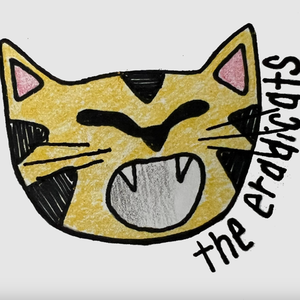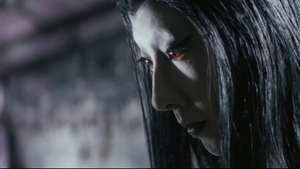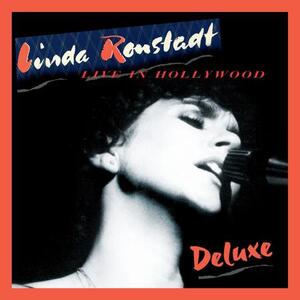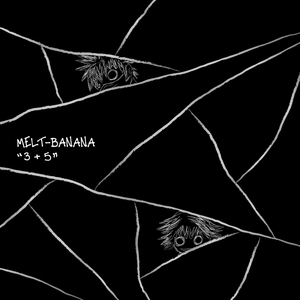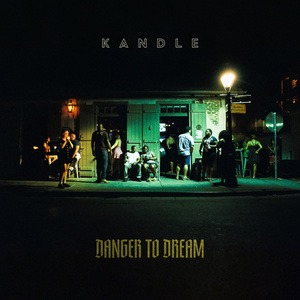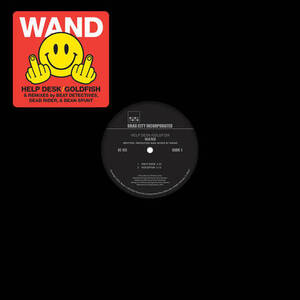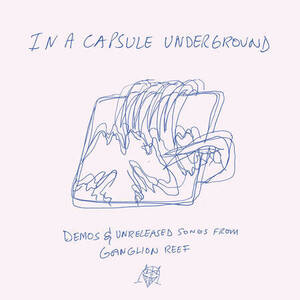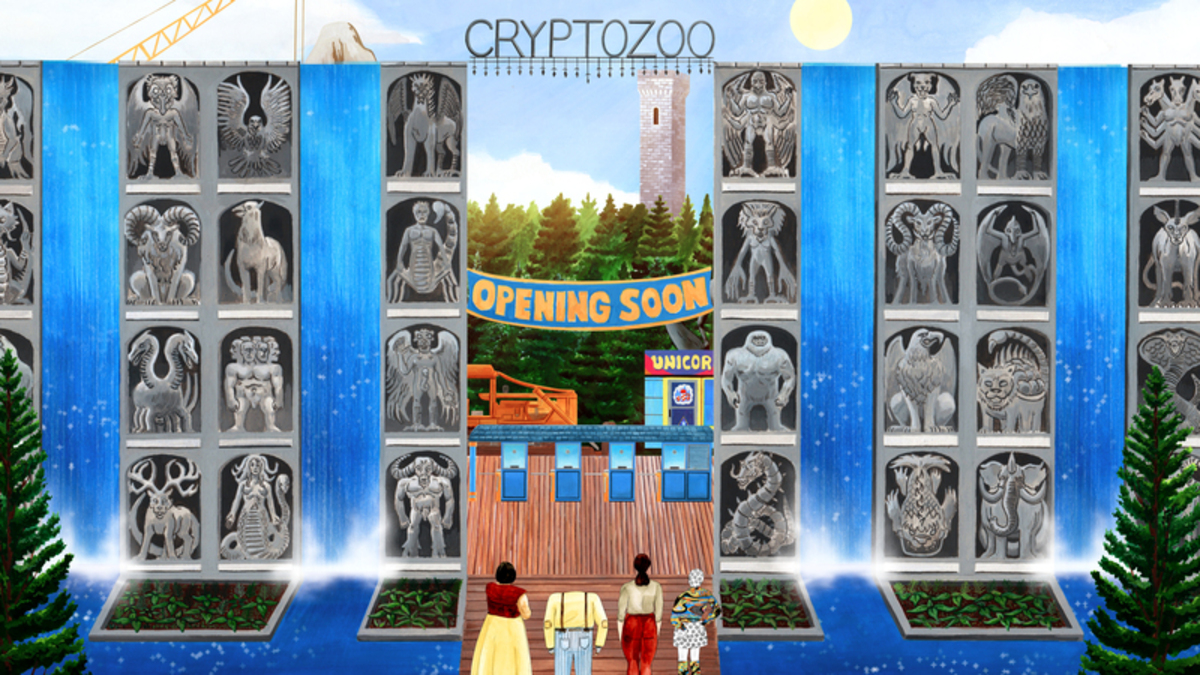
Jane Samborski and Dash Shaw
by Lily and Generoso Fierro
Some time back in 2013, we were perusing the shelves of our local comic book shop, and a short comic book, ambiguously entitled Three New Stories, hypnotized us. Its layered color washes, unexpected collages, and heavy figure lines pulled us into the world and aesthetic of Dash Shaw, and we’ve been admirers of his comics ever since.
In 2016, we had the privilege of interviewing Shaw to talk about his debut animated film, My Entire High School Is Sinking Into the Sea. A collaboration between Shaw, who was the director and writer, and his wife, Jane Samborski, who was the animation director, the film accomplished a handmade, playful, and bold style indicative of Shaw’s comics that perfectly matched the whimsical plot. For their second feature, Cryptozoo, which premiered at the Berlinale in 2020 and Sundance Film Festival in 2021 in the midst of the pandemic, the duo increased the scale of their film and pushed their animation style and techniques to new heights, and the outcome is a spectacular visual world simultaneously grounded in fantasy and reality that meets the demands of the narrative and themes of Cryptozoo.
At the opening of Cryptozoo, we meet the hippie couple, Amber (Louisa Krause) and Matthew (Michael Cera), on a prototypical self-discovery experience in a forest somewhere in California in the 1960s. The two find a large, ominous barrier wall and scale it, expecting to find something defense related, but their hopes of discovering a nefarious governmental secret fade when the two encounter a unicorn roaming the forest behind the barriers. In an act of foolishness that becomes a perfect representation of how the desire to experience anything and everything can go utterly wrong, Matthew, in attempting to touch the unicorn, startles the creature and is gored by its horn. And Amber, in her grief, kills the unicorn and wears its horn on her neck. Gone are the peace and love hippies we met at the beginning: in their place, on full display, is the ugliness and mess left behind when members of the naive love generation tread into places where they should not be and try to experience things they do not (and cannot) understand, cementing a theme that flows continuously throughout the film.
After the shock of the unicorn death, we meet Lauren Gray (Lake Bell), a champion of cryptids, creatures that exist based on folklore, myths, and individual accounts, but have never been identified as known species by the scientific community. Lauren has committed her life to rescuing cryptids in trouble after a baku consumed her bad dreams as a child and has been the lead conservationist and veterinarian of the Cryptozoo, a sanctuary for cryptids funded by an eccentric heiress named Joan (Grace Zabriskie) and the place that Amber and Matthew unfortunately trespassed into. However, the Cryptozoo, in its noble intentions to protect cryptids and raise awareness around the creatures, treads into the same shaky moral grounds that zoos face when trying to preserve endangered species while showcasing them in captivity in order to sustain and finance their conservation efforts. When Lauren embarks on a mission with Phoebe (Angeliki Papoulia), a cryptid who can disguise herself as a human, to find and save the baku from the US military, we watch on with curiosity to understand how deeply Lauren has bought into the vision of the Cryptozoo, and dread that the baku will inevitably end up in captivity either as a spectacle for entertainment or as a counter-intelligence weapon.
Like the Cryptozoo itself, the film traps the viewer in an era and in a setting where we know the outcome. Though the cryptids themselves are fantastical by definition and in their visual design, their introductions within the Cryptozoo evoke less wonderment and more unease because we invariably know that the fate of the Cryptozoo will be grim based on the actual history of the environmental optimism and good intentions of the 1960s that came to nothing (and even sometimes to the malevolent) in the decades to come.
We sat down with Samborski and Shaw to unpack the consequences of environmentalism and conservationism in the 1960s, the influences for the rendering of the cryptids along with considerations to avoid problematic exoticism in Cryptozoo, and the role of manga and comics in the animated films that the duo create. ◼
Q (Lily Fierro): Jane, it’s so nice to meet you! We interviewed Dash in 2016 at AFI FEST for My Entire High School Is Sinking Into the Sea. We’ve long been fans of Dash’s comics, and we’re so excited for you both on the success of Cryptozoo. A lot has happened in five years for you both: you left New York for Richmond; you started a family; you did an animation for an episode of 13 Reasons Why. How did all of these events blend together and lead into the genesis and creation of Cryptozoo? What did you take away from your experiences from My Entire High School Is Sinking Into the Sea and the projects you’ve done together since?
A (Dash Shaw): There was definitely a whole lot going on at once when My Entire High School Sinking Into the Sea premiered: Jane was pregnant; our baby was born in November of 2016; Trump was elected; and, we moved to Richmond. There was so much there all at once, so I felt like I spent a couple of years afterwards just recovering from all of those things happening. The 13 Reasons Why piece was really wonderful, as we enjoyed doing that little two minute animation, and that sort of became the foundation for how we approached Cryptozoo. Jane learned how to do a structured production line for Cryptozoo from that 13 Reasons Why section. Also, I drew the characters in that 13 Reasons Why clip based on the actors—they aren’t rotoscoped from the actors, but they are figure drawings of the actors, and that kind of became the hope for what Cryptozoo would look like.
A (Jane Samborski): One of the big things that we learned from My Entire High School Is Sinking Into the Sea is just—and every person in the world who wakes up and goes to work in the morning knows this—that you get up; you do your project; you have a structure; and, you complete it all little by little, and having that structure is integral, absolutely critical to finishing things. And all of that gets thrown out of the window when you have these huge life changes. I remember feeling adrift until I started working on Cryptozoo and 13 Reasons Why. A project is the thing in my life that frames the other things. There needs to be a separation between the two, but they don’t need to conflict with each other. By having time to devote to the art and to the larger project, I don’t feel like I am floating around. Right now, for example, I feel floaty because we are in between projects, and I am aching for the next project to start because being in the project is where I am the happiest—knowing that I get to wake up and solve animation problems.
Q (Generoso Fierro): There are many references and inversions of Disney animation conventions in Cryptozoo. A significant one is the opening scene, which we feel is a nod to the killing of Bambi’s mother, a moment which is sometimes considered as a spark for the modern environmental movement. How influential were those early perspectives and efforts of environmentalism on your decision to set Cryptozoo in the 1960s?
A (DS): When I started writing the movie, I had a fellowship at the New York Public Library, and one of the other fellows there was researching countercultural newspapers of the 1960s, and the New York Public Library had all of them in their archives. So, there would be this 1967 free weekly paper from Brazil and another alternative paper from that same week in Chicago, and both would have that same kind of incredible utopian optimism, as well as a particular stylistic quality that was consistent across all of these papers that is almost like a Winsor McCay, thin line, famous new artists look. When I think about people discussing all of these different key moments of the 1960s, the one that was key for me in the genesis of Cryptozoo is the moment when Walt Disney died, and Epcot Center, which was supposed to be an actual city where people would live, was turned into just another amusement park. Amusement parks are products of imagineers, so these places are supposed to be dream worlds where anything is possible, but of course, in actuality, they are very dictated spaces where you feel kind of trapped. And this becomes especially clear in a place like Epcot Center where they are trying to present the whole world to people who haven’t been all over the world, and the choices in representation that were made can seem bizarre. So, in regards to Disney as an influence, I was thinking more about Epcot Center than the Bambi moment, but totally, when you’re rendering the death of a unicorn, it’s something that is so symbolic that it needs extra attention to also be realistic. Jane gets ninety percent of the credit for making that moment actually painful and not a joke and not simply a symbolic, abstract thing happening. That was super important to the movie. You know, Amy Taubin wrote about Cryptozoo for Art Forum, and she mentioned the relation to the Bambi death scene as well, and she described the scene as “hyperreal,” and I think that that is a perfect thing to say about the death of the unicorn, hyperreal.
A (JS): Something else that makes the 1960s a good pairing for this film is that when you think of the 60s, you think of this intense idealism and this drive to fix things, but we are many years out from then, and we know that it didn’t exactly work out. And so, when you’re telling this story where you know from the beginning that the Cryptozoo is going to fall and that the principle discussions that the characters are having with each other are about “how to make the world better,” the 1960s are a time and place that set up a good framework that resonated well with the themes in the movie.
Q (LF): In the film’s narrative, Dash, you touch on how the Cryptozoo theme park, in its displays of mythical creatures from all around the world, treads into problematic territories of exoticism. We understand that, Jane, you designed all of the cryptids, and naturally, in rendering them, you could have also tread into similar difficult areas. How did you ensure that the cryptids weren’t overly exoticized or caricaturish? For example, the baku’s swirls allude to similar swirls in Japanese prints, but they are respectful in their homage.
A (JS): I think honestly that is just me having fun, as I love to paint. I really enjoy the act of painting, and so, I am approaching each of these creatures as a kind of puzzle. I am looking at early renditions from the source cultures, because every cryptid is from its own culture in real life, and it wasn’t difficult because every time I would look at those images, there would be something in them that I was excited about. But, it is all going to come through the filter of Jane. I am the artist that I am. I can only change it so much. And so, I think just focusing on the joy and the honesty of the source material and what I was going to bring to it, I would then end up with a genuine product, I hope.
A (DS): What you are talking about is something we definitely spoke about while making the movie. The goal, I believe, is that, just like all the characters in the movie, to have sincere reasons for why we’re doing the things we do. So, the movie is somehow a collage that is looking at these different motivations and their relationships with each other and with the audience. We were definitely aware of thinking that they have to have a very good reason for creating and running the Cryptozoo that we can believe, but we are also outside of it and judging it as an audience member, and so modulating our experience of that was then the hard thing to keep our eyes on while making the movie.
Q (GF): In making the film, did your perspective on the role of the human in conserving the natural and the unseen evolve over time?
A (DS): So, this is my art school answer to your question: it used to be that people would see a landscape painting as a kind of frivolous, low-genre painting that is cheesy and that has nothing to offer us. There is a Brecht poem that states, “What kind of times are these, when to talk about trees is almost a crime,” meaning that there is all of this other stuff going on in the world, so why would you paint a landscape when it is totally lame and unnecessary relative to everything else? And now, someone like David Hockney is spending years painting those trees, and, in many ways, they are the most politically relevant paintings that you could make. They are so powerful and important, and so I hope that the landscape paintings in Cryptozoo have some of that feeling because now I feel that it is a crime not to talk about the trees.
A (JS): I think the other thing is that the world had changed a lot over the course of the making of the film. Dash wrote that script before Trump was elected. We had the summer of racial justice as we were coming to a close. We had a very surprising resonance with a line early in the film. I think that when we wrote it, it felt very theoretical. Of course, we were interested in the idea that we were presenting, and believed in those ideas and those questions, but by the time the film actually came out, they felt very real.
DS: You know they played My Entire High School Is Sinking Into the Sea at a theater near where we are and watching that movie again now has a lot of different things that relate to it too.
LF: I think that Cryptozoo is incredibly relevant because there have been more studies coming from academia and conservation that are thinking about how humans can play a role in other species’ evolution. This film is very timely because questions about if and how humans should help species adapt and survive are becoming more important as the environment changes. A great example is in the Great Barrier Reef where, right now, there are scientists who are trying to breed heartier types of coral that can survive the rising temperature of the ocean, but that also has a variety of implications on the environment in the future that we just don’t fully know about today. And so, I think that Cryptozoo plays with similar ideas very well.
JS: Yes, that’s a great example of someone who has this really wonderful idealistic notion, and it’s great if it works, but we always have to be checking in with our idealism to make sure that it’s still steering us in the right direction.
Q (LF): There’s a moment when Lauren and Phoebe go to Kentucky that sticks out in our minds. Lauren suggests that Phoebe would have an easier time in a large, more liberal city. Phoebe informs Lauren that having more space and privacy would be better. It made us realize that the city looms over the film as a concept, but we never really see it. How mindful were you both of the role of physical distance and isolation in the work of Lauren, Joan, and Phoebe? Cryptids, after all, live on the periphery of our notions of reality.
A (DS): Well, I think that you should be our therapist, Lily (laughs) because you’re tapping into something here. I didn’t consciously do this, but yes, at this moment right now, I am consciously thinking about how Lauren would think that the city would be more progressive than how Phoebe sees the reality of it.
A (JS): I remember this more clearly than Dash, I think, but Dash was the impetus for leaving New York. I was fine to stay, but Dash got to this point, especially after his fellowship ended where he said, “I cannot handle people everywhere,” and I get it because there is nowhere that you can go in New York without people everywhere. In our apartment, we could hear other people all of the time, and he started to find that very oppressive. And now he finds the lack of people oppressive (laughs).
DS: I love New York!
JS: But he was desperate to escape. He just doesn’t want to remember that (laughs). And you know, absence makes the heart grow fonder. You remember what you loved about the place that you lived in before. But the thing that you pointed out, there is even more to that because there were a couple of shots that took place in cities that were cut, but they were all in that crazy mayhem section of the film at the end, and so we were just destroying the city, and that was the only city-related content. So, not only did you see what was in the film, but you magically saw what was not in the film too!
LF: It might just be a personal bias because I’ve experienced that feeling of how the city drives you nuts, and you decide to leave it, and then you have some fondness for it, but finally you are glad that you’ve left.
JS: Yeah, that one snuck in under both of our radars, so I’m glad that you alerted us to it.
Q (GF): One of the strongest elements of Cryptozoo is this convergence of reality and fantasy throughout the film. One excellent example of this is the sequence in which Lauren talks about her childhood in Okinawa, where there’s a blending of illustration and archived imagery, and altogether, they pay homage to gekiga illustration styles and topics. Could you talk about the research and development process for this sequence?
A (DS): Well, I thought that Lauren needed to be connected to her childhood because many people have this love of mythological beings that’s rooted in their six year old selves. So, that had to be a real enough motivation for her to do what she does. It’s not like in Indiana Jones where they establish early on that this is the good guy of the movie. Once they [Lauren, Phoebe, and Joan] are buying the child cryptid, you can see that this is kind of fucked up, but this is also why we thought that we shouldn’t start the film with her and why we should start with these hippies stumbling across the Cryptozoo. Therefore, I thought that rooting her character in her childhood was the most important way to show that she had a sincere motivation. In terms of the gekiga, I first heard about the baku in an experimental manga anthology called Comic Baku, but I had never heard of the creature before that. I should also say that I was a sixteen year old living in the south of Nagoya as a teenager, so I have had this love of Japanese comics in me from that time in my life. Also, in high schools in Japan, the whole school takes a trip together, which is a bit weird because you end up in a hotel with all of your classmates in your junior year, and you all go to baths together, but it is a standard thing. And on our particular trip, we all went to Hiroshima. I bring this up because it has some conscious or subconscious influence here.
GF: Thank you for sharing that, as I found the blending of ideas there to be an interesting choice.
DS: To clarify, is your question more about the technical blending or the story blending?
GF: It is a bit of both actually. There is a technical element in that we believe that it is the only scene where any archival-like footage exists.
DS: The idea of the collective trauma of the bombings of Japan during World War Two is played out in so many anime where they are still processing this horrible event that happened. Also, with incidents like school shootings, the archival footage has a similar connection to this kind of “duck and cover” imagery, which I think is traumatizing for a lot of children today as well. As for that decision on the combination of archival and drawn images, I think that it is about the boundaries of our fantasy movie where the fantasy world and reality are close to each other and how that can be disorienting. This is opposed to so many fantasy movies where there is a very clear allegorical space that is removed from our world, and you are kind of outside of it: Cryptozoo is closer to our world, and it’s bumping up against our world, which is unusual and interesting.
JS: Yes, I think that a lot of those decisions come out of this place where we need to express this idea and ask: what visual ideas can we throw in there, on top of it, that make sense? I know that originally there was just straight archival footage there, but it didn’t feel right. And that is a very intuitive process and part of what is so fun and joyful about the film is that Dash and I were doing the bulk of the creation of assets, and we had a lot of other people coming in, so each scene is kind of compartmentalized, and we were looking at this space and asking, “How can we make this as exciting as its own little short film?” And how can we marry these elements and be true to the intent of the original artist? And so, the whole film is very much a collage and very much about how we can make this work.
DS: There are collages that try to melt everything together, and then there are collages where things still have their individual integrity as separate elements, and you are creating the associations and connections between these separate parts. I think that I lean more towards the latter.
Q (LF): Manga definitely has influences on the visual style of Cryptozoo, but I also wanted to talk about the influences of comics on the dialogue in the film. Economy and compactness of dialogue is a part of your comics style, Dash. How much of that approach to dialogue did you transfer or walk away from when creating Cryptozoo, which is more complex in concept than My Entire High School Is Sinking Into the Sea, and yet feels more sparse in its conversations and narration?
A (DS): The best way that I can answer that, and I don’t know if this is a good answer, is that comics are so different from movies and that one thing that helps out in comics is that words take up physical space, so you learn to reduce things down. Even when you are lettering a panel, you’re often, in the act, deciding to cut certain words out. Good comics writing is like Peanuts or something like that, in that it has a very reduced and refined kind of an exaggerated abbreviation, and that is sort of like Hollywood movie dialogue. Meaning that people are speaking in this kind of heightened way that is a little more effective than the Rohmer version of dialogue. There are definitely parts of Cryptozoo where I tried to tap into that.
A (JS): Also, with this project, we knew that we could potentially get some really amazing actors. With My Entire High School Is Sinking Into The Sea, the film was created with normal dialogue for normal people to say, but with Cryptozoo, we had more confidence going in that we could have more heft with the words.
A (DS): But, I do think that there is some kind of alternative comic contrarian impulse in me to write some cartoonish dialogue and then see a weird positive quality emerging from it in the film. There are some key scenes in Cryptozoo that I can think of as an example of that quality, such as where the antagonist Nicholas says, “We’re not so different.” That is such a cliché to have him say that, but, in a way, it is like a moment you would expect in a Hollywood movie, and cartooning is often a similar exaggeration of a pre-existing thing or idea. So, in the end, I think that it is a contrarian impulse.
Cryptozoo opens up in selected theaters and begins streaming this Friday, August 20.
This interview has been edited for clarity and length. Photo courtesy of Magnolia Pictures.




